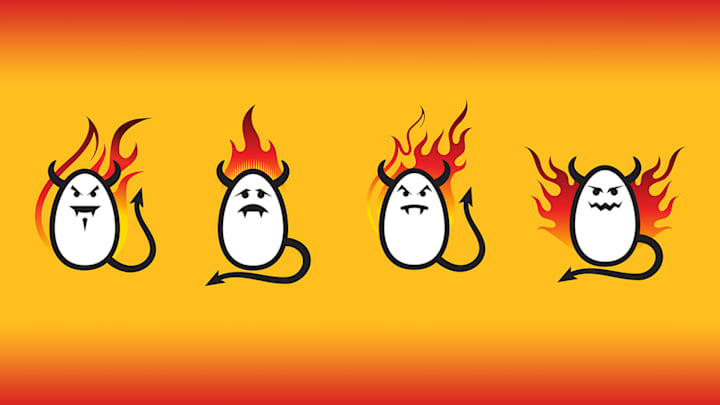It’s a testament to deviled eggs’ hallowed place in side dish culture that we routinely utter their diabolical name with no questions asked.
But we do have some questions. For example, is there a version of Genesis wherein Eve’s forbidden fruit is a stuffed egg? Are the hard-boiled halves meant to evoke the glowing yellow eyes of Satan himself? Was the inventor of the dish just a guy named John Devil?
Sadly, no, no, and no.
The Devil You Don’t Know

As far back as the late 18th century, people used the word devil for “any of various highly-seasoned savory dishes,” per the Oxford English Dictionary. In his 1788 work, Brother Peter to Brother Tom: An Expostulatory Epistle, English satirist John Wolcot mentions how “diabolically hot” a “downright devil” is and then devotes a whole stanza to explaining exactly what he meant by that:
“By Dev’l, (without thy being born a wizard)
Though ought’st to know I mean a turkey’s gizzard;
So christen’d for its quality, by man,
Because so oft ’tis loaded with [cayenne]—
This dev’l is such a red-hot bit of meat
As nothing but the dev’l himself should eat.”
Wolcot’s implication that devils are so named because they’re too red-hot for anyone but the devil to eat might be poetic license: Sources often attribute this sense of devil more broadly to the comparison between Hell’s heat and the heat of a spicy dish. The term was even sometimes used to refer to spices or spiciness in general.
With regard to parts of speech, devil was quite a versatile word. You could also use it as a verb meaning “to prepare food with hot and spicy seasonings” or as an adjective to describe food prepared in that manner. In other words, you could (and people did) devil a biscuit and then eat your deviled biscuit.
The Devil Wears Paprika

The earliest known reference to deviled eggs is from Five Years Before the Mast, Jacob Hazen’s 1854 account of his experiences on a whaling ship and a man-of-war. “I’ve had one supper to-night already,” his friend says, “but I don’t care to go a second cargo on deviled eggs and Bologna sausages.”
Whether those deviled eggs lived up to their name is anyone’s guess—but 19th-century recipes for the dish probably wouldn’t impress anyone who carries hot sauce in their bag. A typical filling featured egg yolk, melted butter, vinegar, mustard, and salt and pepper, with the occasional mention of a “little red pepper,” “curry,” or “deviled ham.”
These days, deviled eggs usually get their kick from cayenne pepper or paprika sprinkled on top. If that’s hardly red-hot enough for your fancy, there are all sorts of recipes for “spicy deviled eggs”—which you now know is a pretty redundant name.
Find Out How Other Foods Got Their Names:
